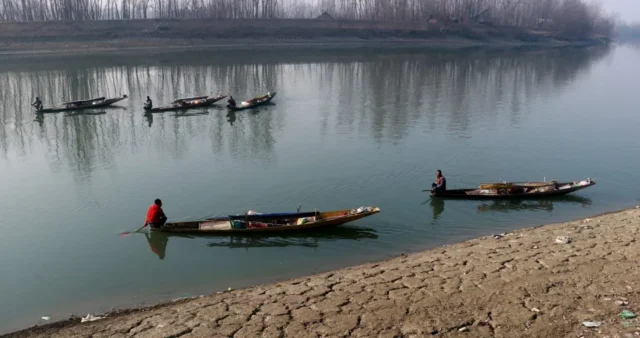Srinagar, July 2: Prolonged heat wave and an unprecedented dry spell have pushed the Jhelum river and its tributaries to record lows, with the water level at Sangam in south Kashmir’s Anantnag district dipping to just 0.19 feet on Wednesday ó the lowest reading in at least five years for this time of year.
The gauge stood at 0.59 feet on Tuesday, and had already fallen to 0.57 feet by June 30, according to the Irrigation and Flood Control Department.
ìThis is not just an anomalyóitís a full-blown water crisis,î said a senior official from the Hydraulics Department in Srinagar. ìSangam usually records levels between 5 and 7 feet in early July.î
Jhelumís other tributaries ó including the Vaishaw in Khudwani, which originates from Kausarnag-Aharbal in Kulgam and serves as a major feeder to the Jhelum, Brengi in Kokernag, Sandran and Veth-Vethastu in Verinag, Aaripal in Tral, and Tongri and Romshi Nallahs in Pulwama ó are also flowing well below normal levels for early July, a time when glacial melt typically sustains their discharge.
Wular Lake, Asiaís largest freshwater body, has also fallen below the seasonal average. As of July 2, its level stood at 1574.97 meters, compared to a normal of around 1578.00 meters.
The dry spell has already begun affecting day-to-day life. Irrigation networks across the valley, dependent on the Jhelum and its tributaries, are under severe strain. In Pulwama, a farmer, Mushtaq Ahmad said canals feeding farmlands are ìalmost dry,î leaving crops to wither.
Being the main source of water for irrigation and drinking purposes, the Jhelum is considered to be the lifeline of Kashmir. The river is facing a serious ecological threat due to unabated pollution, siltation besides flow of sewage and dumping of garbage. Originating from Verinag in south Kashmir, Jhelum spans over 175 sq Kms, meandering in a serpentine way from south to north Kashmir
The drinking water supply has been severely affected due to the ongoing dry spell and receding water levels in rivers and streams.
ìThough we receive potable water, the pressure is low, and it just dribbles from the taps. If the situation continues, we might face a drinking water crisis,î said Muhammad Shaban, a resident of uptown Srinagar.
However, an official from the Public Health Engineering (PHE)ís, Jal Shakti Department said the situation is not critical yet.
Experts attribute the sharp drop to early snowmelt in March-May and over 50% seasonal rainfall deficit.
ìThere is less than 25% water in the Jhelum right now,î said Peer Manzoor, a senior official in the Irrigation Department. ìIn some places, the river is just 6 inches deep, and dropping fast. Just five days ago, it was 13 inches. Three weeks ago, it was 20 inches.î
The early glacial runoff occurred months before peak irrigation demand, worsening the crisis in the critical sowing season.
Precipitation remains at its lowest, with the Meteorological Department in Srinagar forecasting light to moderate rainfall at scattered locations between July 2 and 5, followed by rain or thundershowers between July 6 and 8. However, no strong or sustained monsoon system is in sight.
With the water levels breaking historical records and the immediate forecast offering limited relief, officials warn that Kashmir could be staring at one of its worst water crises in recent history. Department data reveals just how drastic the drop has been in 2025 compared to the past four years.








